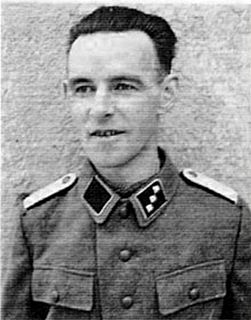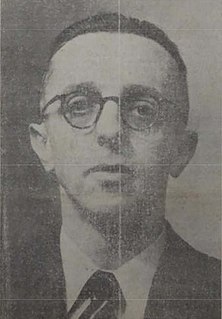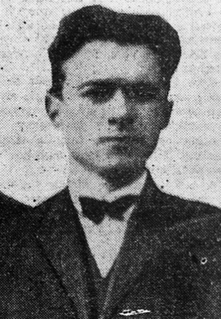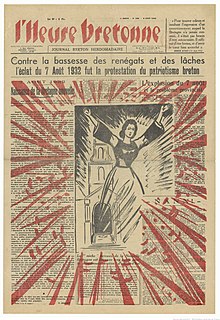Related Research Articles
Gwenn ha Du was a paramilitary group founded at the end of 1930 in Paris by Célestin Lainé. It advocated Breton nationalism through "direct action" and published a secret manual aimed at instructing readers in terrorism. The phrase "Gwenn ha du" is the nickname for the Breton flag, which is in these colours.

Célestin Lainé (1908–1983) was a Breton nationalist and collaborator during the Second World War who led the SS affiliated Bezen Perrot militia. His Breton language name is Neven Hénaff. He was a chemical engineer by training. After the war he moved to Ireland.

Breiz Atao, was a Breton nationalist journal in the mid-twentieth century. It was written in French, and has always been considered as a French nationalist journal by the non-francized Bretons. The term is also used for the broader movement associated with the journal's political position.
The abbé Jean-Marie Perrot, in Breton Yann Vari Perrot, was a Breton priest, Breton independentist assassinated by the Communist resistance. He was the founder of the Breton Catholic movement Bleun-Brug.
The Breton Social-National Workers' Movement was a nationalist, separatist, and Fascist movement founded in 1941 by Théophile Jeusset. It emerged in Brittany from a deviationist faction of the Breton National Party; it disappeared the same year.

Olier Mordrel is the Breton language version of Olivier Mordrelle, a Breton nationalist and wartime collaborator with the Third Reich who founded the separatist Breton National Party. Before the war, he worked as an architect. His architectural work was influenced by Art Deco and the International style of Le Corbusier. He was also an essayist, short story writer, and translator. Mordrel wrote some of his works under the pen names Jean de La Bénelais, J. La B, Er Gédour, A. Calvez, Otto Mohr, Brython, and Olivier Launay.

Before and during World War II, the various Breton nationalist movements were generally right-wing, and sometimes fascist. The extent to which this led to collaboration with the Nazi occupiers of France during the war, together with their motivations, is a matter of historical controversy.

François Debeauvais was a Breton nationalist and wartime collaborator with Nazi Germany. His name is also spelled in many "Breton" variants: François Debauvais, Fransez Debeauvais, Fransez Debauvais, Fañch Debeauvais, Fañch Debauvais, Fañch deb.

Morvan Marchal, is the Breton name of Maurice Marchal, an architect and a militant Breton nationalist. He is best known for having designed the national flag of Brittany.
The Breton Federalist League was a short-lived Breton political party in the 1930s. A new organization with the same name was created in the 21st century.
The Breton Autonomist Party was a political party which existed in Brittany from 1927 to 1931.
Maurice Duhamel was the pen-name of Maurice Bourgeaux, a Breton musician, writer and activist who was a leading figure in Breton nationalism and federalist politics in the years before World War II.
Morvan Lebesque, was the Breton language name of Maurice Lebesque, a Breton nationalist activist and French journalist.

Théophile Jeusset was a Breton nationalist writer and fascist political activist. He is also known by his Breton language pseudonym Jean-Yves Keraudren.
Gwilherm Berthou was a Breton nationalist and neo-Druidic bardic poet. He was a member of the Breton artistic movement Seiz Breur.

Erwan Berthou was a French and Breton language poet, writer and neo-Druidic bard. His name is also spelled Erwan Bertou and Yves Berthou. He also used the bardic pseudonyms Kaledvoulc'h, Alc'houeder Treger and Erwanig.

L'Heure Bretonne was a Breton nationalist weekly newspaper which was published from June 1940 to June 1944. It was the organ of the Breton National Party and was strongly associated with collaborationist politics during World War II.

The pointe de Pen-Hir is a promontory of the Crozon peninsula in Brittany, to the south-west of Camaret-sur-Mer. On a clear day there are views to the Pointe du Raz and the islands of Sein and Ouessant and to Pointe Saint-Mathieu. The cliffs are as tall as 70 metres (230 ft) high.
Jean Le Fustec was a Breton bard, and the first Archdruid of the Goursez Vreizh. He is also known by his Breton language name Yann ab Gwilherm and his Druidic name Lemenik.
References
- ↑ Breiz da Zont, July, 1931, «C'est en fonction de leur résistance particulière à la conquête du territoire français par les idées dissolvantes qui émanent plus ou moins des Juifs : maçonnisme, laicisme, etc., que les Bretons ont été décimés au cours de la derniere guerre mondiale, plus de 200 000. Il est facile d'invoquer pour cette hécatombe des raisons militaires, mais rien ne fera contre ce fait que le répartiteur réel des troupes pendant toute la guerre fut le Juif Abrahami, né … dans le ghetto de Constantinople.»
- ↑ Daniel Leach, "Bezen Perrot: The Breton nationalist unit of the SS, 1943-5", e-Keltoi